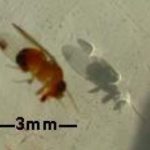Sclerotinia stem rot has been observed in scattered canola fields through the canola disease survey. In most fields levels are low, but incidence was about 50 per cent in a field in the Carman area. Blackleg symptoms are easiest to identify when stems are cut at the base. The perfect time to scout is at harvest, so bring your clippers along
Sclerotinia seen in canola, aphid populations rise in soybean crops
Manitoba Insect & Disease Update for August 16
Rain falls, but more needed; cereal harvesting, canola swathing begin
Manitoba Crop Report and Crop Weather report for August 14
Warm weather has advanced crops, and also caused some injury in canola. Rainfall occurred throughout the province, but more rainfall is needed in many areas. Harvest has begun in winter cereals, spring cereals, and field peas. Canola is starting to be swathed. Insect monitoring is on-going, but disease incidence remains low. Haying continues, but in
Hot weather advances crops, hurts some canola in process
Manitoba Crop Report and Crop Weather report for August 8
Moderate to hot weather from past weeks has advanced crops, but also caused some injury in canola. Rainfall occurred throughout the province, but in many areas more is still needed. Harvest has begun in winter cereals and field peas with good yields and quality reported. Insect monitoring is on-going in many crops, but disease incidence

Beneficials on the rise against soybean aphids, root rot, fusarium in fields
Manitoba Insect & Disease Update for August 2
Diamondback moth continues to be a concern in some areas, although it is the pupa stage that is now dominant in some fields. Soybean aphids surpassed economic threshold in some fields. In some soybean fields natural enemy populations seem to be building in response to the soybean aphids. Bertha armyworms are being monitored, and high levels of larvae have
Winter wheat, rye harvest begins, many areas dry
Manitoba Crop Report and Crop Weather report for July 31
Winter wheat and fall rye harvest is underway in Central Manitoba. Grass seed harvest has begun in Central Manitoba and the Interlake. Many regions in the province are below normal precipitation and would benefit from rain. Most of the Southwest and Northwest received less than 5 mm of rain over the past week. Heat unit
Controlled crop residue burning authorizations begin Aug. 1
Manitoba Agriculture reminds producers who choose to burn crop residue that authorization is required from Aug. 1 to Nov. 15. Daily authorizations are issued by 11 a.m. based on weather and smoke dispersion conditions. Night burning continues to be banned year-round. The daily authorization will indicate if burning is permitted or not, and the start
Weather conditions see crops quickly advance, disease, insect pressures low
Manitoba Crop Report and Crop Weather report for July 24, 2017
Hot and humid weather conditions across much of the province are advancing crops quickly. Winter cereals and some early seeded spring cereals are starting to turn. Areas in the Southwest, Northwest and Central regions are well below normal precipitation and would benefit from rain. Thunderstorms brought damaging winds and hail to some areas of Manitoba.

Aphids turning up in cereals, peas
Aphids have been a concern in some cereal and pea fields, according to Manitoba Agriculture’s latest insect and disease update on Wednesday. Aphids have also been reported in corn, and isolated incidence of turnip aphids have been found in canola, the province said. Thistle caterpillar and their webbing continue to be quite noticeable in some

Thistle caterpillar, aphids, stripe rust appearing
Thistle caterpillar and their webbing continue to be quite noticeable in some soybean fields, the provincial agriculture department reported Wednesday. Aphids are at high levels in some cereal fields in the central region. Soybean aphid has been found in some fields in the central region, but currently just at low levels. Additional reports of stripe

Surveillance turns up strawberry, raspberry pest
Low levels of spotted wing drosophila (SWD) females and males (one to two per trap) have been found in traps in southern Manitoba, the provincial government reported Tuesday. As raspberries start to change colour and ripen in mid-July, an insecticide could be applied to protect that harvest, which is expected to start in one to

